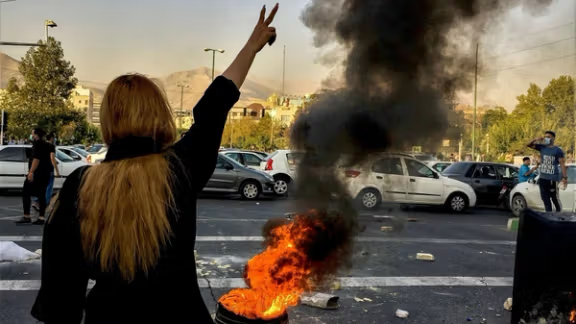Compiled by the Artistic Freedom Initiative (AFI) and Voices Unbound (VU), the 100-page document urges the global community to recognize art as a form of political resistance and to take immediate steps to safeguard artists facing persecution.
Despite condemnation from the international community, the report says dozens of Iranian artists are serving prison terms, and some face execution as a direct result of their creative work.
The protests in Iran, sparked by the death of 22-year-old Mahsa Jina Amini in September 2022 after being detained by the so-called morality police for allegedly wearing "improper hijab," quickly escalated into a nationwide uprising.
The "Women, Life, Freedom" movement, as it became known, saw Iranians from across the country calling for regime-change and voicing their opposition to systemic discrimination, repression, and violence by the Iranian state.
Tehran, in turn, responded with a brutal crackdown, imprisoning tens of thousands of protestors on arbitrary grounds to punish them for their participation and discourage them from taking part in future protests. Hundreds were killed in the security apparatus’ efforts to stifle protests.
While several previous publications have documented the widespread human rights abuses committed by Iranian authorities, this new study shifts the focus to the central role of art and artists in political resistance.
Although artists like renowned rapper Toomaj Salehi have long been targets of state persecution, the analysis reveals that the regime has intensified its tactics, imposing severe censorship, imprisonment, and even torture on those who dare to express dissent.
By presenting comprehensive accounts from artists, the document illuminates the critical role many played in amplifying the voices of the 2022-2023 protests through their creative work and exposes the legal mechanisms used by Iran's judicial system to suppress dissent.
While providing new insights into how these legal tools are systematically used to suppress artistic expression and silence opposition, the report also provides a comprehensive analysis of how the Iranian government has systematically targeted artists who supported the movement.
It reveals the various tactics used by the regime, such as censorship, surveillance, arbitrary arrests, forced confessions, travel bans, and extraterritorial repression, to silence these artists. This highlights a pattern of suppression specifically aimed at controlling artistic expression, which the report argues is a form of resistance in Iran's repressive environment.
The report draws on interviews and testimonies of artists like Zhinos Taghizadeh, Nazanin Nourozi, and Yalda Moaiery who have experienced censorship, exile, and prosecution.
Moaiery, a photojournalist, was detained while capturing images at one of the initial Woman, Life, Freedom demonstrations in September 2022.
Moaiery told AFI and VU that she was given no explanation for her arrest. After being identified by police officers while she was in prison, Moaiery was separated from the other women protestors and placed into solitary confinement for extended periods. Moaiery, who is currently in the US, explained that she had been arbitrarily detained and tortured by authorities several times throughout her career prior to this instance, and that the experience of being subjected to solitary confinement continues to weigh heavily on her mental and emotional health.
In urging a redefined understanding of artistic expression as a significant form of political dissent and its critical role in the “Women, Life, Freedom" protest movement, the report and several contributors call on the international community to take urgent action to support Iranian artists under threat.
They call for the provision of more resources for legal aid, creating safe haven and immigration pathways, amplifying their voices globally, and imposing targeted sanctions on those persecuting them.
“The international community must acknowledge the invaluable contributions of Iranian artists as defenders of human rights,” Johanna Bankston, Senior Officer of Human Rights Research & Policy at AFI, said in a press release. “It is imperative to support their courageous efforts and ensure their safety amidst ongoing persecution.”
The report says its recommendations aim to protect artistic freedom and ensure that Iranian artists can continue to resist oppression and share their powerful messages with the world.







